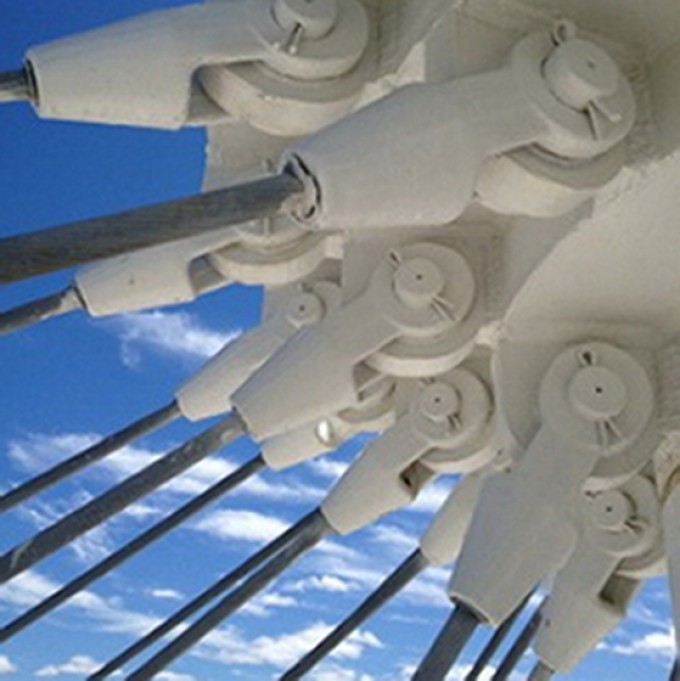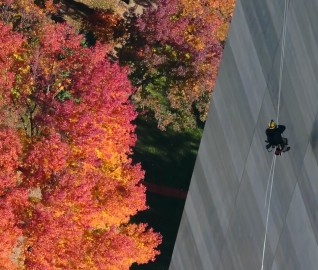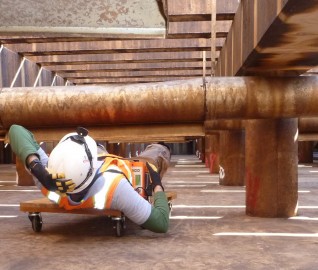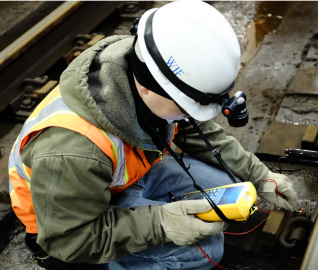WJE PROJECTS
Cable-Stayed Roof Structure


CLIENT |
CBRE managed property |
LOCATION |
Deerfield, IL |
Structural Cable Inspection
The exterior cables of the roof system at a midwestern corporate headquarters are exposed to weather and, unlike stays or suspender cables in many cable-supported bridges, no outer jacket or other covering is present along the length of the cables. As a result, the condition of the cables is entirely reliant upon the galvanized coating of the cables for corrosion protection. During an inspection in 2007, surface corrosion was observed on the surfaces of the exterior cables in several localized areas.
BACKGROUND
The campus of buildings was constructed circa 1973. The roof framing of one building consists of a grid of structural steel wide flange beams with continuous, fully welded end connections. The beams are suspended from a series of galvanized steel cable stays, which are anchored to two large vertical masts that extend approximately 36 feet above the roof. Forty-eight 1-1/4-inch diameter cables extend radially from the top of each mast anchorage attached to the top of the roof framing. Twenty-four 3/4-inch diameter cables extend from the underside of the roof framing to an intermediate anchorage on each mast, providing lateral stability and resistance to wind uplift forces.
SOLUTION
Each suspender cable is composed of many small diameter steel wires that are wound in a helical pattern. During WJE's inspection, some cables were noted to have localized discoloration or light surface corrosion beginning between the individual cable strands. Also, near the upper ends of several cables, water dripping from the top row of clevises onto cables anchored at the two rows below caused areas of the lower cables to experience prolonged exposure to moisture. Accelerated wear of the galvanized coating in localized areas and the onset of corrosion began as a result. Spreading of the individual wires of the cables in these areas was observed at one such location. Abrasion of the galvanized coating along the length of the cables was also observed to have caused moderate surface corrosion in localized areas.
The level of corrosion did not pose a structural concern. However, since these cables serve as the primary structural support for the roof, WJE recommended a more frequent inspection cycle to establish the rate of progression of the corrosion on the cables. To avoid the expense of constructing scaffolding around the cables to facilitate access for inspections, WJE was retained to utilize industrial rope access techniques to access the tops of the masts and to inspect the lengths of the cables and their anchorages. Climbing, rappelling, and ascending were utilized to provide arms-length inspection of the cable anchorages at the tops of the masts as well as at an assortment of cables during each inspection.
RELATED INFORMATION
-
 We employ our industrial rope access team or drone capabilities to provide clients a solution to... MORE >Services | Difficult Access and Drone Survey
We employ our industrial rope access team or drone capabilities to provide clients a solution to... MORE >Services | Difficult Access and Drone Survey -
 When the integrity or condition of a structure is in question, clients rely on us for answers MORE >Services | Structural Engineering
When the integrity or condition of a structure is in question, clients rely on us for answers MORE >Services | Structural Engineering -
 We have pioneered the use of nondestructive evaluation methods—such as ground penetrating... MORE >Services | Nondestructive Evaluation
We have pioneered the use of nondestructive evaluation methods—such as ground penetrating... MORE >Services | Nondestructive Evaluation



































